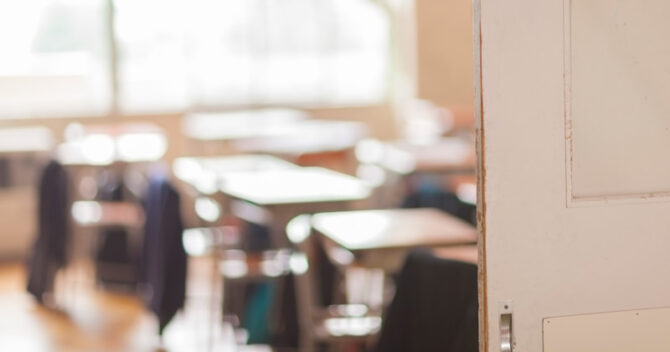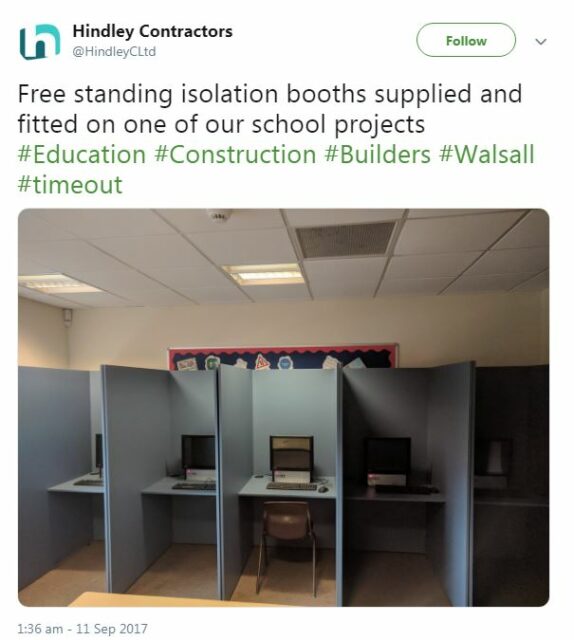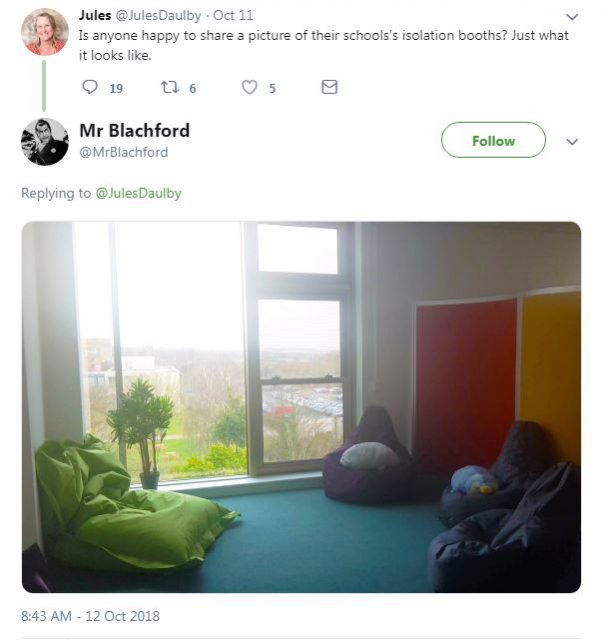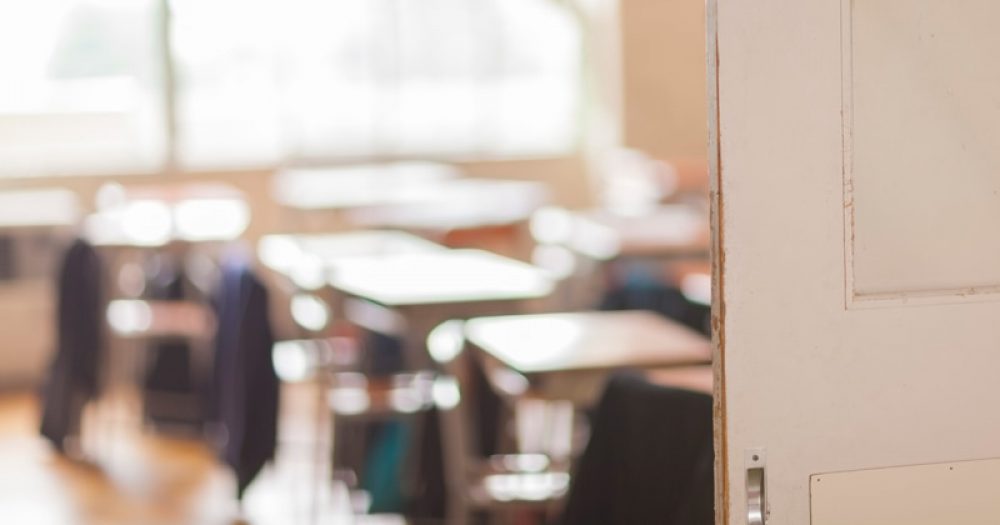Primary schools are using isolation rooms to punish pupils as young as five years old, with some secondaries admitting they are willing to put older pupils into seclusion for up to five days in a row.
A Schools Week investigation has today lifted the lid on the scale and details of how schools across the country use isolation as punishment for unruly pupils.
The rooms are spaces separate from the classroom, where pupils are sent as a behaviour-management intervention. Many schools use them as part of an escalating set of disciplinary measures.
Our research found over two-thirds of the country’s largest academy trusts have schools that use some form of isolation, although with varying labels from “inclusion units” and “consequence booths” to “time-out spaces” and “calm rooms”.
At least four trusts used isolation or intervention spaces on primary-school pupils. That included the Ark Academy chain, where 20 out of its 38 schools had isolation rooms.

Primary pupils can be removed for a maximum of half a day, and secondary pupils for up to a week.
Behaviour policies for St Barnabas Multi Academy Trust in Cornwall state pupils will be moved to a “reflection room” if they break a rule for the fourth time.
The trusts said they are used for children from year 1 upwards. Youngsters can remain there for up to one day.
Other trusts said they could put a pupil in isolation for up to a week, while many others give pupils generic online resources instead of the equivalent work from lessons.
Isolation booths are the bleakest sign of an institution giving up
Our findings were echoed in major research published by the Department for Education on Wednesday that found a majority of secondaries, and a minority of primaries, make use of “internal inclusion units”.
Both maintained schools and academies use isolation spaces but academies are more likely to do so, according to the research. However most schools don’t have evidence that such strategies actually work, the report found.
The use of isolation was criticised in a Guardian newspaper article earlier this year that revealed the Outwood Grange Academies Trust, which runs 30 schools, does not allow pupils in isolation rooms to look left or right, chew, tap or sigh – rules one parent dubbed “barbaric”.
Another critic has claimed isolation booths are the “bleakest sign of an institution giving up”, and are largely used for pupils with learning or emotional difficulties.
But OGAT said the rooms were a place for pupils to calm down and reflect. Many trusts told Schools Week the rooms also allow for supportive conversations without disrupting lessons for other pupils.
Most schools use some sort of isolation rooms
Schools Week sent a freedom of information request to the 90 largest academy trusts asking if they use isolation rooms. A total of 71 responded, of which 48 (68 per cent) confirmed at least some of their schools used the rooms.
Only three trusts – Surrey-based GLF Schools, St Barnabas trust and Cambridge Meridian Academies trust – said all their schools make use of isolation spaces.
Of the 10 largest academy trusts, three did not provide full responses. Academies Enterprise Trust and Ormiston Academies Trust did not respond at all, and Harris Federation said its academies may use supervised isolation rooms but it could not provide further information.
Mark Lehain, interim director at pro-free school group New Schools Network, said it would be a “rare” school that didn’t have a place where pupils could be separately educated.
It would be a rare school that doesn’t have a place where pupils can be separately educated
Good schools will know when an isolation room could be “overly detrimental to pupils’ wellbeing”, he added.
However some trusts clearly oppose isolation rooms, with 22 chains saying none of their schools used them.
A spokesperson for the Surrey-based Bourne Education Trust, which includes five secondaries, said pupils have one-on-one conversations with staff but the trust “does not believe isolation rooms work”.
Trusts which cater specifically for pupils with special educational needs are also unconvinced.
The Eden Academy Trust, which has seven special-needs schools in Middlesex, said isolation rooms are an “ineffective behaviour-improvement strategy” for pupils with learning difficulties.
Schools Week approached several councils on the use of isolation rooms in their schools but was told details could not be obtained.
Even primary schools are secluding pupils
Sean Powers, interim executive principal of St Barnabas trust, said pupils from year 1 upwards – aged five or six – can be placed in what they call “reflection spaces”. The spaces are only accessed when “really needed”, with a record kept of the removal and parents informed, he said.
Ark states it provides a separate space for pupils who “find it difficult to manage their behaviour in the classroom”. Primary pupils are removed for a maximum of half of a day and secondary pupils for up to a week. The trust said pupils engage in reflective and restorative activities.
REAch2 Academy Trust, which has 60 primary schools, said it does not use isolation spaces, but pupils may be removed from lessons to complete their work separately.
Three out of the five primary schools under the Cheshire-based Heath Family (NW) trust use isolation rooms for up to one day. Chief operating officer Craig Parkinson said these were “warm and supportive environments” which include therapeutic activities to help children.

Finally, three of four schools with the Northern Ambition Academies Trust, which only has one secondary, remove pupils to “intervention spaces” as a last resort, preceded by other interventions. Pupils can be removed for a whole day but only if they have been aggressive.
But Jules Daulby, director of education at the Driver Youth Trust, said removing primary pupils should be used to calm them down, not as a punitive measure when schools “don’t know what to do with them”.
“If you’ve created a room for these isolations in primary school, and a paid member of staff is in there too, then the money you’re paying that staff member should go on preventative help instead.”
Isolation rooms are ‘bleakest sign of institution giving up’
Paul Dix, chair of the alternative-provision TBAP Multi-Academy Trust, has claimed in his book on behaviour When the Adults Change that a “room with isolation booths is the bleakest sign of an institution giving up”.
Such spaces tell children that adults don’t know what to do with them, he wrote.
Many trusts told Schools Week the isolation rooms are an alternative to fixed-term exclusions – and help to reduce permanent exclusions.
For instance, the Collaborative Academies Trust said being sent home makes pupils “happy”, so an internal exclusion is preferred.
However, the latest exclusion data shows pupils with identified special educational needs accounted for around half of both permanent exclusions and fixed-term exclusions.
The removal of a pupil must be meaningful to them
Dix believes more than 80 per cent of pupils in any isolation room are likely to have additional needs, including “hidden needs” such as trauma, anxiety or neglect.
Leora Cruddas, chief executive of the Confederation of School Trusts, which represents academy trusts, said it is right leaders seek to make schools a “safe and scholarly environment”.
However the removal of a pupil must be meaningful to them to enable them to change their behaviour, she said, with interventions assessed “on a case-by-case basis”.
‘She will fall behind’
Many parental complaints about isolation rooms relate to why pupils were sent there, and how long they remain.
Schools Week can reveal 10 of the 44 trusts that divulged how long pupils remain in isolation rooms had schools in which youngsters can remain in isolation for up to one week.
Airedale Academy in Castleford, part of the Northern Ambition Academies Trust, says in its behaviour policy that pupils in isolation must “have both their break and lunch in isolation” too.
A primary teacher who did not wish to be named told Schools Week her year 7 daughter has become anxious and unhappy at school since being repeatedly placed in isolation at a secondary.
The parent claimed the isolation resulted from her daughter chatting in class and not wearing the correct uniform.
The pupil is “only in there with a few books” and the parent claimed she was not told her daughter had been isolated.
However DfE guidance does not state parents must be informed their child has been placed in isolation, nor that the school must record isolation or internal-exclusion statistics.
Daulby has called for regulations requiring schools to record how many times and how often pupils are placed in isolation.
The school concerned is also part of a trust that told Schools Week its isolation rooms have positive benefits.
Responding to the wider question of the use of isolation rooms, Jon Coles, chief executive at United Learning Trust, said schools must have environments in which pupils will obey simple instructions without a long discussion.
But he warned against the “workhouse feel” of punishing pupils in a way that teachers would not punish their own children.

Pupils given ‘online resources’
Another issue is whether pupils are missing learning time. More than half (52 per cent) of 47 trusts who answered our question on this said pupils in isolation did not get identical work to their classmates.
For example Delta, Maltby Learning, Oasis Community Learning and Alpha academies trusts said pupils may get work “appropriate” for their age group instead.
Northern Education Trust in Newcastle, which has 20 schools, said pupils can read using the Accelerated Reader software or get work packs.
But the Education Endowment Foundation said the programme had only a “modest” impact on weaker readers in secondary school, offering about three months extra progress.
What the guidance says
The government’s statutory behaviour guidance is vague, with the DfE stating disruptive pupils can be put in isolation for “a limited period of time” which is left to schools to determine.
Schools must “act reasonably in all circumstances”, and any use of isolation that prevents pupils from leaving a room “of their own free will should only be considered in exceptional circumstances”.
Pupils’ time in isolation should be as constructive as possible, it adds.
The government has also used the Blessed Trinity Roman Catholic College as an example of using an “on-call” room for pupils removed from lessons. The room is successful because it is used to help pupils “reflect on their behaviour and cool down from the incident”.
A spokesperson for the DfE said it is “up to schools to decide what forms of discipline they adopt, as long as they are lawful and used reasonably”.







“most schools don’t have evidence that such strategies actually work, the report found.”
Most teachers, however, certainly do have lots of evidence that leaving one or two highly disruptive pupils in the class completely ruins the education of all the other students in class.
“rules one parent dubbed “barbaric”.”
What is “barbaric” is parents who bring up their kids to behave like animals with little respect for rules or anyone at school. What is “barbaric” is that some parents think it is okay for their child to destroy the life chances of other children. What is “barbaric” is that some parents think it is the school’s job to sort out the dreadful antics of their child rather then themselves.
“The parent claimed the isolation resulted from her daughter chatting in class and not wearing the correct uniform.”
What a significant minority of muppet parents who like to write to minor newspapers don’t get is that sometimes, their little darlings tell fibs; students are placed in isolation because they are out of control, won’t follow instructions and continue to disrupt others’ education despite numerous warnings, not because they have forgotten a book or their shoelaces are undone.
I expect in some cases kids haven’t been bought up properly but in many cases school is a toxic environment. My son can be charming, he knows his manners and he knows when he’s being rude but mainstream school was a disaster for him:and this had a knock on effect for the whole family. Anxiety can cause bad behaviour, my son often felt overloaded on large classrooms so would misbehave to get out. My son is not good with praise and would answer back, so teachers would praise him more and this made him angrier and angrier. He eventually got diagnosed with ASD but it took until he was 14 and by this time the damage was done, he was lacked a brat, I was labelled a bad parent. I took my son out of school and guess what, on every course and work experience placement he’s been polite and done as he’s told, school is toxic for some kids. I don’t blame teachers as individuals for my son’s plight I blame a empathyless culture and big classes for this.
I couldn’t agree more. What a non exposé – schools use isolation rooms for those students who behaviour is adversely affecting the education of others – this is such an accepted and commonplace strategy that I am surprised that Schools Week has never heard of it before – possibly indicating their actual knowledge of schools is more limited than it should be.
The bottom line is that this strategy is not employed for the benefit of the student who is sanctioned but for the benefit of the other 29 students in the classroom who now will be able to learn from their teacher; who beforehand was constantly having to deal with the misbehaviour and disruption of a badly parented child.
It would be useful if you could consider the fact that some adults tell fibs also. Nobody is right all the time and many schools adopt this approach simply because they can due to the caveats in their behaviour policies. Schools have very little in their armory to deal with unruly pupils who disrupt classes, however, just to apply a sanction purely because they occupy an autocratic position is an abuse of the limited powers they have. Unbridled power is dangerous in any circumstance
BAD PARENTING is all I keep hearing. It looks to me like education needs to develop but teachers are too far detached from children it’s ridiculous. Yes there are children who are disruptive but that will always happen. This strategy simply isn’t the best solution.
Blaming parents again is not the best reaction.
Another thing I’d like to add, most teachers do not dress to the correct standards either so therefore teachers must be isolated for the same reason as to set the example.
If you set rules then you should stand by them as well to uphold them. There’s plenty of other ways to capture a child’s attention. One Shoe does not fit all. Everyone is different and we all learn differently.
Yes you are lazy to not come up with a more functional way of preventing the child from acting out. If you know the child does that then do something about as a teacher rather then putting them to aside.
Isolation is not really a good term either. In fact it’s within the realms of a form of torture. Yes school isolation is only for a little while however hearing about these isolation booths its causing some children to have anxiety, that is one too many in my eyes. It looks to me that people are becoming very lazy and abusing the system to make something fit.
Human rights is a thing still and those children are still human beings. Treat them how you want to be treated. Show them some respect and character. Be humane and show empathy regardless of wether you think they are bad or good. you as teachers are there to set an example. Stop been lazy and be human again.
Yours aye
Sir Scott.
Thank you for your response Sir Scott, I couldn’t agree more.
Isolating a child or teen is far from a humane response.
My son is 14 and is currently being accessed for autism. He was put into isolation for an incident that occurred outside of school on a group chat with ‘friends’. Two days into isolation he showed undeniable signs of stress and anxiety. He wasn’t sleeping, eating or drinking, he became withdrawn and dehydrated. I can only describe it as inhumane treatment of our young generation. Albeit, some children or adolescents may cope with isolation but there are others who become severely depressed and anxious.
It certainly begs the question, who benefits?
Maltreatment and trauma leads to mistrust as well as other mental health problems. Isolation option is futile in addressing behavioural problems and psychologically it causes more problems. There has been zero evidence to prove that there are benefits from treating children and young people in this way. Also, their education is negatively impacted by treating young humans like this.
It sheds light on the fact that our education system is broken, it is failing our children in so many ways.
Very poor sensationalist article, reporting using words like ‘barbaric’. Losing respect for Schoolsweek with journalism like this. Schools bend over backwards to help all students. Sometimes, because a student is completely out of control and won’t play ball for one of many reasons, schools have to remove pupils for the sake of everyone. Schools are places of learning, not lunatic asylums, yet that is how some students behave. Parents should be forced to take responsibility, leave home or work and come and sort out their children if they lose it in schools. It is not a school’s job to be social worker.
I can’t believe your response to this article. We have a poor Education System in Britain. The League tables are having a massive effect on how our education is delivered…all pupils are individuals who need to be educated with a broad curriculum. Teachers are lazy, overpaid and can’t even be bothered to ensure their lessons are interesting, effective and accessible by all. They don’t correct punctuation anymore and expect pupils to work out of exercise books and copy off the board with no fun content strategy to help pupils engage fully in education. More than half our pupils are visual learners so delivering an academic based curriculum leaves them unable to process what’s being taught. They are lost and abandoned in class because teachers can’t be bothered to educate all pupils fairly according to their educational needs. They then ignore any SEN issues that eventually fester and appear and then lock them up in isolation for not engaging in their substandard lessons. Almost all disruptive pupils have some degree of Primary SEN, if it’s not addressed when it’s quite obvious there is a need there, then they are going to display disruptive behaviour. Then the teachers moan and say the kid isn’t disciplined T home and is rude or lazy, when realistically they have low receptive skills and SpLD’s which In turn leads to social, emotional and mental health issues which they can’t control….please don’t reply…you need putting in an asylum. Our children are being failed!
^^^^ What Dave said.
It is sometimes necessary to remove children from classrooms to enable the rest to learn without disruption. Putting all the badly-behaved pupils in one room isn’t the answer. Yes, it’s a cheap option (many pupils – one overseer) but can be counterproductive. Imagine: a pumped-up pupil in an isolation room kicks off. This has a ripple effect – giggles from some; fear from others. And then there’s the kudos of being sent to the room many times similar to that experienced by pupils who in the not-so-far-off olden days lined up outside the head’s office waiting for a whacking.
Removal is necessary, yes, but it needs careful tracking and handling.
Its a tough argument – everyones viewpoint is valid. I am an intelligent human being. I am an Architect and successfully ran my own business for over 20 years and will go back to it again in the future, however, according to the above (or below) comments I am interested to hear that I am considered to be a bad parent as my child has special educational needs and sometimes struggles to concentrate in class. I ‘have’ given up work so that I can help them and the school, but I am interested very much in the current climate of society where elitism rules.
When I was a child, I was at school with a whole range of students…some disruptive and in those days devoid of diagnosis, yes sometimes the class was disrupted, however it did not make me grow up to have a lack of education, far from it….it made me grow up to be a strong , hard working character with an empathy for others and a knowledge that the world did not revolve around my precious self. If anything it was part of my education. If we start eliminating and pushing part of society aside in denial that they exist and in doing so teaching our children that this is acceptable – I believe that we are treading on delicate waters for the future.
I hope my child grows up to be considerate and becomes someone who understands that the world is not a fair or perfect place and becomes someone who tries their hardest and doest blame others for their lack of attainment in life.
I agree that there needs to be an opportunity to remove pupils from a situation that would otherwise escalate but they should then be returned once the issues have been addressed. What I disagree with is the stance of my local secondary school ( that parents have no alternative to as is rural) that are isolating students whose parents have either refused to dispose of or can’t afford to replace John Lewis or M& S trousers which were acceptable last term to a new supplier of almost identical trousers. One GCSE student has been isolated for his uniform since the return in September despite the trouser he is wearing being the correct style and colour just the wrong brand label!!!
my son started secondary september 2019yes just a mere 4 months .
His struggled to settle ,i have shown concerns over his confidence with education , as quite behind with english , Struggled with friendship and older boys being quite mean . Yes his was naughty and yes i agreed he needed to face consequences of his actions but today he was in insolation from 9.10 until 3.35 pm with 15 mins to grab lunch then they refused to return bag and made him complete 1hours after school detention ….. im sorry that ‘s 7 hours and 25 mins , for a pupil thats gone from a primary school setting {approx 350 pupils } into a secondary with nearly 1500 pupils .
My son is 7 years old; he’s diagnosed with ASD (autism), he’s in a special school. He has profound special needs, his understanding of most things is very limited (hence being in a special school), they introduced these rooms when he was 6 years old. A child who makes a lot of noises associated with his condition (as do most), they have decided the best form of treatment is to restrain him, and put him a “safe room” (padded cell really). Yes, it’s barbaric; Lazy, unskilled, and barbaric.
My daughter is in Y11. Model student who has in all her 5 years at the school never been in trouble. Target grades are all 9. She is in all top sets, plays piano and is good at sport. She has also won school awards and is very ambitious. Therefore not the stereotypical image of the student many of you are suggesting go into isolation rooms. She has never missed a day of school because she wants to do the best she possibly can. Last week she was put into Student Isolation for two whole days for a minor uniform breach. She was devastated and stressed about all the lessons she had to miss. Please do not think that only disruptive children are put into isolation rooms as in this case the use of the isolation room was detrimental to the person’s mental wellbeing and education. To be clear the school has never published this sanction for this particular infringement and students do not appear to be made aware of it either. In this case it was a matter of an autocratic school putting its appearance, literally, before the child’s education and welfare! The use of isolation rooms for anything other than genuinely disruptive children should be banned!
My son is 30 years old. He suffers from social anxiety. A couple of months ago we were talking about when he was at primary school aged 9 and he was telling me how much he hated his form teacher at that time. I knew he didn’t like the teacher but I didn’t know the extent of what had happened to him at that time as I was never informed by the school.
He started the school year as normal but he was a bit of a joker and used to shout silly things out in class and caused distraction. After a few weeks the teacher placed him at the back of the classroom and made him face the back wall. He used to turn round occasionally to see what was going on in the classroom and so the teacher had a big notice board brought into the classroom and it was placed in front of him so that he couldnt see anyone of the other pupils and they couldnt see him. The was a small gap at the side of the board and each day after all the other pupils had been given their work a pupil was given the task of bringing his work to him. He couldn’t see over the board and couldn’t see the white board, the teacher or the other pupils. He was allowed to mix with the pupils for 15 minutes during morning and afternoon breaks but was continually watched by the teacher and if he was considered to be naughty he would be brought back into the school and placed back behind the segregation board.
At lunch time he would have to go to the canteen and sit on a table on his own and as soon as he had finished his lunch he had the teacher or a member of the dinner staff would take him back to the classroom where he was again made to sit behind the board in silence while the teacher sat at his desk. In the afternoon the same happened. He had to sit behind the segregation board where he couldn’t interact with any of the other pupils.
This regime went on every day for a year.
I wasn’t aware of what was going on and was never informed by the school that there was any problems with his behaviour or that he was being segregated every day.
I remember him mentioning once that the teacher made him sit in front of a board but I thought he meant that he was made to sit in front of the whiteboard.
He used to make excuses up to get out of going to school and with what I know now I can understand why.
I am absolutely livid that they ostracized my 9 year old son from the rest of the class for a whole year because he was a bit of a distraction.
The humiliation, that he must have suffered must have been horrendous not to mention how it effected his mental health.
He became a very angry young man and I could never work out why but now I understand why.
The way they treated my son can be described as nothing but cruel.
He now believes that this is why he has suffered from mental health issues in adult life.
Is it illegal to lock the door when a child is put into isolation?
I’ve just been informed that my daughter is in isolation on her birthday. This was for missing several homework assignments and minor breaches which add up to an isolation. This is not in the spirit of the intended, i.e. to stop unruly aggressive behaviour and for a child to calm down. Added to this i am told my daughter will be escorted to the toilets and not permitted her break and lunch time exercise. That did it for me, my child is being treated worse than a prisoner who are permitted 45 minutes of exercise per day to gain vitim D.